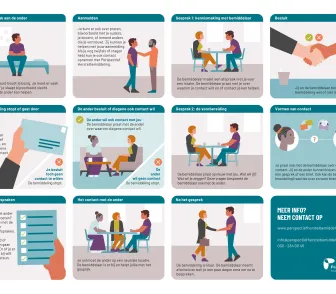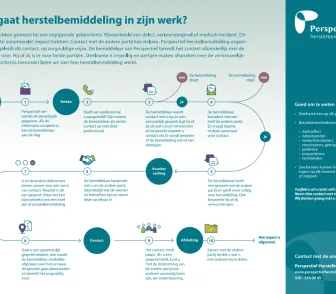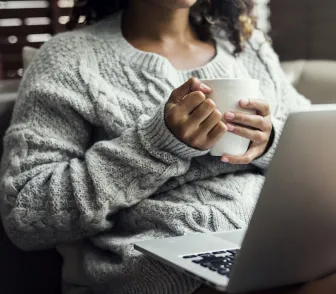When you sign up for restorative mediation, there are a number of standard steps that are followed. On this page we explain what those steps are and what you can expect. You can also watch the video below for an explanation of how restorative mediation works.
On this page you can find all videos with information about restorative mediation, and experiences of participants.
Good to know
- Restorative mediation is voluntary and free of cost.
- Restorative mediation can happen at any time, shortly after the events, or years later.
- All participants can start, pause, or quit the mediation at any point.
- The contact is confidential.
- The mediator is neutral and prioritizes the wants and needs of both parties.
- If you do not speak (good) Dutch or English, or if you are deaf/hard of hearing, we can arrange an interpreter for you who will translate. This does not cost money for you.
1. Contact with the registration point
- After we receive your application, the registration point will contact you first, within three business days.
- They will call you or e-mail you to give more information about restorative mediation, to answer questions, and to discuss when a mediator will contact you to make an appointment for an intake.
2. The intake with the mediator
- The mediator will make an appointment with you for an intake. In this intake you can discuss with the mediator why you want to get in contact with the other person, and what your wants and needs are.
- The mediator can give more information about how the process works and what you can expect, and can answer your questions.
- After this intake, you can also decide you don't want to get in contact with the other person after all. In that case, the mediation stops.
3. The mediator contacts the other person
- If you decide you want to get in contact, the mediator will send a letter to the other party to ask if they also want to get in contact with you. That person can freely decide whether to respond or not.
- If the other person also wants to get in contact, the mediator will talk to them as well about their wants and needs, and why they want to get in contact with you.
- This way, the mediator can assess how the contact can be helpful to you both.
4. Preparing the contact
Before you and the other party will get in contact with each other, the mediator will prepare the contact with you.
Choosing the form of contact
- A meeting: The mediator prepares this contact with both parties and guides the conversation.
- An exchange of letters: The mediator will support the participants in this process.
- A shuttle mediation: The participants don't actually meet: the mediator will communicate questions and answers back and forth between both parties.
- A video or audio message: The participants can record a video or audio message for the other party with the help of the mediator.
- A group meeting: This happens when multiple offenders, victims, or others that were involved in the same event want to get in contact with each other. Think of a traffic accident in which multiple people were involved.
Choosing a location
If you decide that you want to have a meeting, the mediator will choose a neutral location that you both agree with.
Discussing details
- It can be nice to have decided on a few things beforehand. Such as who will be in the room first, whether you will shake hands, or who sits where.
- You can also bring a someone with you to support you, like a family member, friend, or casemanager. The other person can also bring a supportive figure. The mediator will discuss this with both of you beforehand.
- These agreements make sure that everyone already knows more or less what to expect, and can reduce tension.
5. Closure
- After the contact, you and the other person decide together which things you talked about can be shared with other people.
- In most cases, one meeting is sufficient, and the mediation ends.
- A few weeks after the mediation, the mediator will call you to ask how you experienced the mediation and how you look back on it.
- Lastly, you will receive a closing letter from the mediator. With this, the mediation is completely finished.
Did you know?
Besides regular restorative mediation, we also offer other options. For example, between victims and their families, offenders and their families, or dialogue groups. On this page you can read more about it.
Apply
You can apply for restorative mediation on this page.
If you apply, this doesn't mean we will immediately contact the other person, or that you commit to getting in contact with them. We will first discuss with you why you want restorative mediation, and what is important to you. Only once you give permission, the mediator will contact the other person.
Ervaringen van anderen
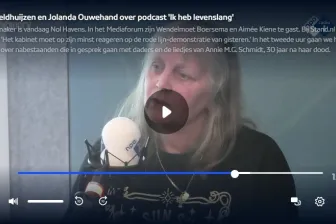
In 2021, Jolanda’s son Perry (21) was killed when his then 17-year-old friend Damian stabbed him in a parking lot. “For a long time, I had no idea what had gotten into him. Only once I got in contact with him, I got answers and peace,” Jolanda says, who talked with Damian and later also his parents.
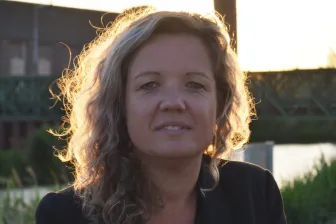
When she was 43, Gaby had a conversation with her uncle, who sexually abused her when she was a child. “I wanted to hand the secret and the responsibility regarding all of this back to him, and with that take back my agency and my freedom."
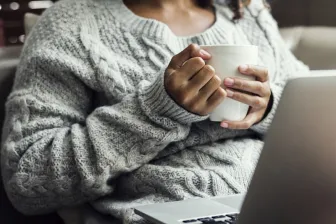
Esther* (49) experienced sexually transgressive behavior when she was a student. She tucked the experience away and hid from it, but the memory of that night recently resurfaced. She decided she needed to do something about it, and applied at Perspectief to get in contact and talk with the other person about what happened.
